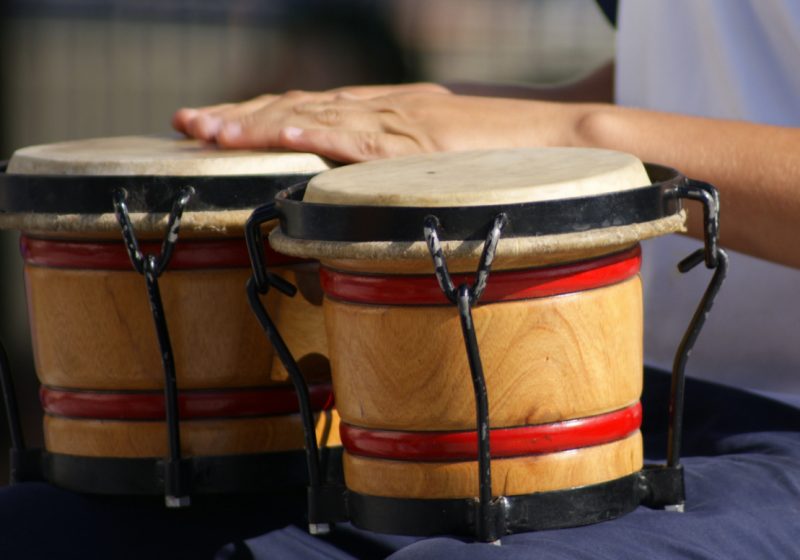
My Story: I first started drumming over forty-five years ago. While vacationing as a little boy in Puerto Rico with my parents, I sat by the hotel pool in front of the salsa band, amazed and intrigued. My father had no idea what he was getting me into! I was disappointed at the hotel Christmas party when my friend got the bongos. My gift was a toy car.
After we returned to New Jersey, I bugged my dad, a jazz enthusiast, to get me a Mexican conga drum. In the mid-70’s there were no conga teachers around, so I took drum lessons.
For a time, my father was part-owner of a commercial music magazine, a “trade rag”called MMR. He was sent and then brought home free albums every week. One cover, with its ornately-carved drums and the beaming smile of the artist, intrigued me. It was Olatunji’s classic, “Drums Of Passion”, which has subsequently sold in the millions.
Listening to Olatunji, Osibisa, Stevie Wonder, Earth Wind & Fire, and Santana, I practiced day and night on Indian clay bongos. In high school I joined a jazz fusion band. There were no hand drummers where I lived so I took formal drum set classes and learned drum rudiments that I still use and practice today. My father would play records of various jazz musicians and pretend to conduct them in front of the living room mirror in the mantel. His favorites (that I can now remember) were Miles Davis and John Coltrane, so I grew up with this exposure as well. I never got to play with Miles but I did get to perform with Olatunji in Golden Gate Park later on!
During the summer, I hung out with my Greek-American friends, who were aspiring musicians. Underage and hungry for live music, we snuck into a local club at the beach. The conga player, amused by our enthusiasm, let us play his drums during the breaks. Despite being underage, we were never thrown out. These Greek kids, Nick and George, ended up being very influential in my life and development as an artist and musician. They were both incredibly positive and supportive. I have found that positive reinforcement from others has been a major help and pushed me to excel in my life. I am deeply grateful and thankful to all those who have encouraged me along the way!
In high school my small group of eccentric artist and music friends and I befriended an older kid named Kenny Nolan who was a local jazz drummer. He lived downtown and we would hang out in his apartment and smoke weed while he would play different jazz artists and explain and teach us how to listen to the drummer in the group. I had no idea until he focused me in like this. He was able to co-produce a few shows where some of the jazz artists like Albert Bud Johnson were able to perform in our small town.

At Rhode Island School of Design I joined the very mixed up and lively jazz orchestra, in spite of my lack of training. I was playing congas in a night club one evening when the sax player’s friend came. Without asking, he set up his three congas in front of the stage, playing on every song, continuing even when the band stopped! The saxophone player who was fed up with my inspired but awful playing had invited him.
When I asked him why he played so much without being invited (by me), his reply was unforgettable: “If you don’t play with or listen to musicians better than you, you won’t learn or improve.” At this point, I was a “thunder drummer”, banging away with no technique. This interaction changed my life. It humbled me and helped me to see there was a path, and first a road to cross.
Shortly thereafter, I left art school to devote myself to music. It was a major turning point in my life, one that would alienate me from my family. I had a moment where I had a cathartic experience, I realized I could take one of two paths as a fine artist or as a drummer. I also knew that drumming would be the harder path. But I chose it anyway.
In Boston I studied drums and macrobiotics, a way of life dedicated to healthy eating, food, meditation and the like. I lived in a study house, worked in local health food stores and restaurants, never lasting too long at any one job. I was able to study natural cooking, shiatsu massage, and wholistic healing extensively during my two years or more there. I dabbled in an out of my father’s businesses but was never able to fully embrace them. I could not find the art in “selling”, although these days I have been doing marketing for various percussion companies. Now I am working with Wula Drum and have done projects for Gon Bop, Manito Percussion, PM Percussion, and several others.
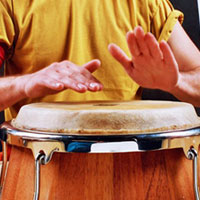
My childhood friend George gave me my first conga lesson, teaching me how to correctly slap the drums and make a variety of different sounds. He explained how drumming was a language and consisted of rhythms and parts. He turned me on to his friend and teacher Nuru, an amazing six-foot tall tower of strength of African-American and white parents. She taught me the fundamentals, a necessity in any discipline.
Excited to be in a group, I paid for my lessons a month in advance and applied myself diligently in the classes, often conducted outdoors. We played for dance classes, something I still do many, many years later.
She taught me more about the language of the drum: that drumming is music, not banging. Furthermore, that traditional rhythms were important in societies, presented at rituals, weddings and public functions. They have names and patterns. There are several parts, with each drummer holding his own rhythm while the lead player solos – talks, you could say – over the steady beat. Drumming has been passed down from father to son, from generation to generation through oral history.
Although it was difficult for me to find others to play with and study in those days because of prejudice, it was even harder for Nuru. Men in the drum community were adamantly against woman encroaching on their turf. Dedicated, we both endured the pressure.
She tuned into a spiritual place and let the music come through her. Beside memorizing rhythms and practicing them, I learned, by observing Neru, the importance of the Circle: being positive, looking at and connecting with the other drummers. Since then, the Circle has been utilized to great effect everywhere from jams on the beach to corporations.

After a stint studying congas, bongos and Latin music with the Pabon brothers, I ventured south to bohemian Key West, FL where I busked for months on lively Mallory Square Pier at sunset. All the nights I jammed and the variety of drummers I played with were infinitely beneficial.
Once I was confident enough, I teamed with some local Puerto Ricans and a dancer and established our own gig at the other end of the pier. Rumba was our thing. Now professional, I paid my rent with rolls of quarters.
The dancer and I embarked on a journey in a beat-up old van, which miraculously delivered us to the West Coast and the glory of California. Soon I was a fixture on the UC Berkeley campus, drumming with musicians I still play with and know, over 40 years later.
One of these guys, named Simbo (Craig Goodman), an innovator and motivator, introduced the local percussion crowd and crew to the djembe, at the time unknown to us. He formed us into ensembles (vocal, too) with lots of hand percussion. Not only that, but he taught us to make shekeres (beaded gourds) and drums from discarded barrels.
I started jamming at the local UC Berkeley campus in Sproul Plaza in 1978, and met several drummers who I am still playing and associated with today. I met Simbo through Jerry Shilgi who is now deceased, but at the time was a regular out there. Simbo introduced the Bay Area, or at least the local drum scene, to the djembe which, for all intents and purposes, was not in use yet. He tried to convince the conga drummers to expand their horizons and try different forms of music. He would entice them to parties that had food – they were nearly always broke, hungry, horny, and looking to get high. After he got them stoned, he would form them into various groups such as all-vocal units or miscellaneous percussion ensembles, including one with only tuned bells.
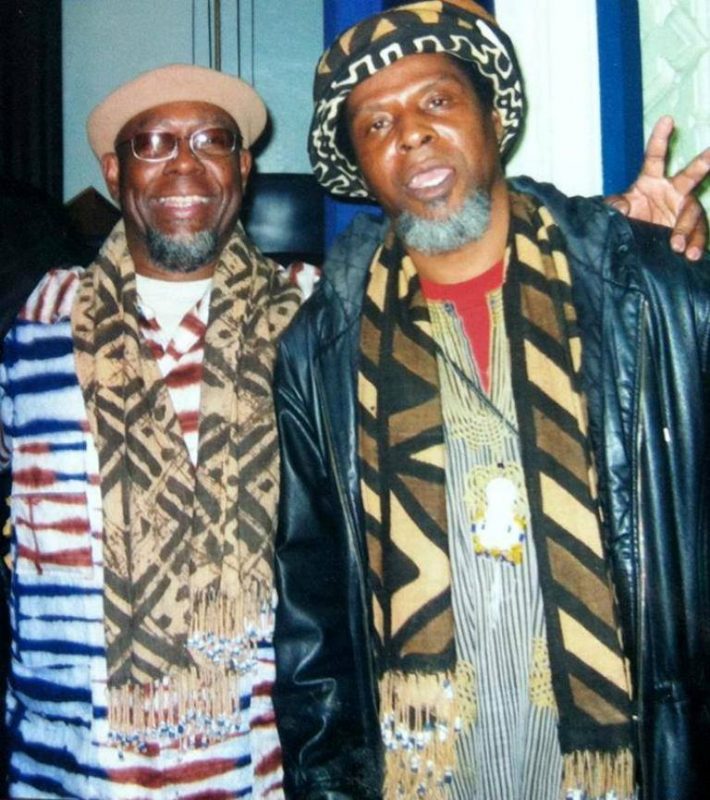
Simbo would experiment with traditional concepts and arrangements, for which he was heavily criticized. Later, the same critics played what he had developed when they heard the Cubans doing them. He was ahead of his time. He orchestrated beautiful African-inspired and Afro-Cuban pieces. An innovator and genius, Simbo was a pioneer in composing such music. He sparked an idea that I materialized, which was to fuse African with Western music. I had the Western instruments play percussive rhythms and blended the traditional chants with Western harmonies, the result being a gentle fusion of East and West.
Simbo put together various performance groups and I was able to perform and get on stage playing djembe, congas, shekere, and other various percussion instruments. Our first group had percussionist Juma Santos (Miles Davis band) in it as well. There were no other white djembe players in California at the time if you can imagine that!
I was simultaneously attending the New College Of California where I got a degree in humanities with emphasis on wholistic health. I have always maintained a high level of interest in natural healing, yoga, and martial arts, beginning with Karate in junior high school and continuing on with different styles of Tai Chi through the years.
It’s important to note that back in the early ’80s prior to the internet there was very little recorded or shared information on West African music and drumming. There were only a few records or recordings of djembe music available, although there were several rumba and folkloric records you could find in the Mission district of San Francisco record bins. What we got, found, and had, was coveted.
If you had a cassette tape of anyone doing any kind of drumming from anywhere you shared it and learned it. Most hand drummers and student drummers played a variety of styles as there was no wealth of information in any one style readily available or easily accessible. If we met someone from Brazil we studied Brazilian. If we met someone from the Congo, such as the late great and amazing Malonga Casquelourd, we studied Congolese.
In 1981 I was the percussion salesman at the Haight Ashburry Music Center (formerly Chickens That Sing Music). It was here that I got to meet and play regularly with the legendary and incredible Armando Perraza, percussionist from Santana. He would walk into the shop, come back to where I was hanging out and without speaking any words to each other, I would sit down and begin to go through my repertoire of pieces holding drum parts and patterns for him while he would solo. The store would immediately fill up with people. It was quite magical. No matter how many people were there he would stop and ask me after each piece, “What is the name of that?” He would also help and correct me.
It was there I also met record producer Ray Gardner (of “Dance Sister Dance” song fame with Santana) who got me into the studio with other percussionists to record world music for the first time.
My next major influence was John Amira, who lived in New York. I studied traditional Afro-Haitian and Afro-Cuban with him in Manhattan. In 1985 I took my first trip to Havana, Cuba to study with the legendary Pello El Afrokan, the inventor of the Mozambique rhythm and dance craze. He introduced it to many of our rumba heroes and other great drummers and musicians in Havana and we got to sit in and play for the Saturday Rumba with the Conjunto Folklorico National and even got us on stage at the famous Tropicana night club.
At the time there was no internet, there were no CDs, and no widely spread information on drumming available to the masses as it is today. It’s inconceivable how little information there was. We took the first consumer grade video cameras to Cuba and came back with rumba, bata, and other folkloric videos of classes and events. This was the first time that home videos were made (with sound tracks) by students of the art and was indeed the beginning of the sharing of information to the masses.
I was traveling to Santa Cruz, California a lot in those days. Marion, the African dance teacher who I was working with, hired me to organize the undisciplined world drum scene there. When I first arrived it was chaos, with several now well known drummers in their drumming infancy. We got the situation together. Some of Marion’s dance classes had up to 150 dancers with lines waiting out the door to get in.
At other local drum classes on the hill at Santa Cruz College, I put people in a circle (like Nuru had) so they would have to look at each other, as opposed to having them sit in a straight line. One of my students, Arthur Hull, has achieved positive results and great success with this method, often in the corporate world, where he stresses a ‘teamwork’ concept.
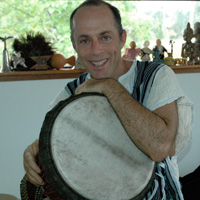
I met Pedro De Jesus in Santa Cruz around this time. Developing an interest in Santeria, I was initiated (“made saint”) into the religion in 1988. Meanwhile, I studied Afro-Cuban rhythms and culture with a variety of teachers, including Regino Jiménez and many other great Cuban teachers who would come to live and teach in the Bay Area over the next 30 years, including Carlos Aldama. Pedro introduced me to so many greats, including Patato Valdez and the legendary Francisco Aguabella who played bata for my first anniversary celebration,”bembe” party as a priest in Santeria. Mickey Hart of the Grateful Dead was in attendance at the Western Addition Cultural Center 31 years ago and was so taken by the experience at my party he mentioned it in his book, “Drumming At The Edge”. Which also has photos of shekeres he hired me to make for him and are now in his traveling museum.
During this era I started meeting people in the recording industry and making friends with studio engineers. I always loved gear and tech. A chiropractor I was seeing named Robert Blackman told me he wanted to produce a couple of songs about “peace” so I introduced him to a young and upcoming engineer named Marc Senesac. Marc mentored me for many years in all aspects of the studio and introduced me to many local musicians and bands, and even got me to make and record a percussion arrangement for the South Bay heavy metal band Exodus!
Marc helped me build my own home studios over many years and in various dwellings, apartments, and houses, where I recorded all kinds of groups, projects and different artist including Fantuzzi , and many other Bay Area musicians.
I contributed percussion on over 25 albums spanning the musical spectrum, worked with Mickey Hart on recordings and projects, and while under contract with Narada Records, produced four of my own CDs.
I also worked with Jerry Garcia on sound tracks for film. Clarence Clemons worked in my home studio on his solo album, where we also were recording commercial music TV ads. I also played for local bands such as The Tubes and recorded on a Todd Rundgren CD, Jim Chappell’s recordings, and many others.
In 1995 I went to Cuba for a second time and studied bata and rumba, but this time in Matanzas, the cultural hotbed of traditional Afro-Cuban folk music. We worked with and studied with many greats, including members of the Los Muñequitos and Afro Cuban groups. It was here that I got my hands “washed” by Alfredo Calvo in the ceremony to play Aña, the sacred set of bata drums used in ceremonies.
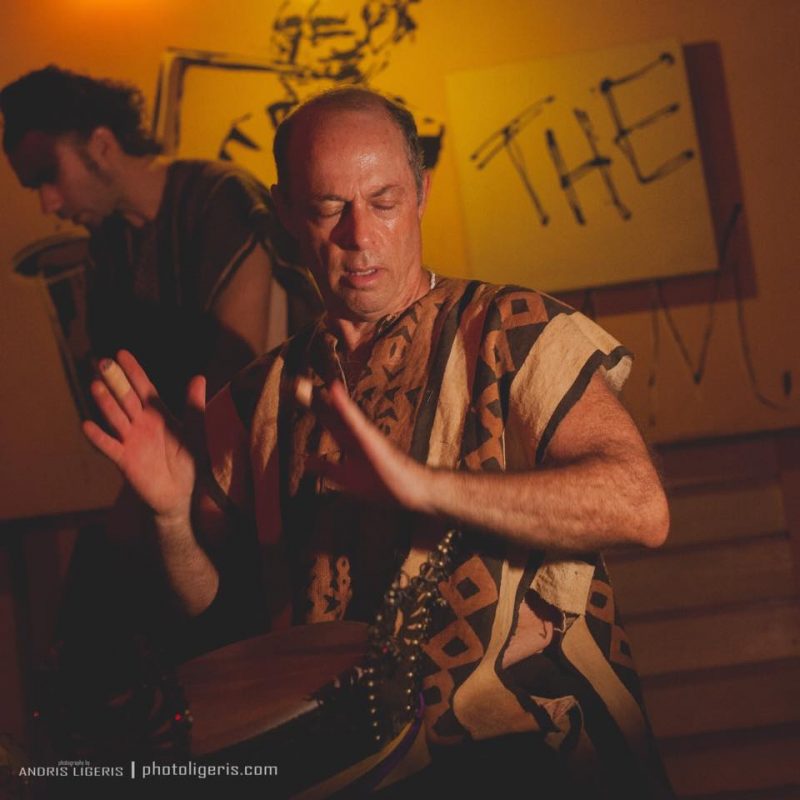
Around 1996 I began re-learning and re-studying formal West African djembe and dundun training when a new wave of percussionists, many my students’ students, entered my social sphere. They were friendly, knowledgeable, and open-minded, unusual in the highly-competitive, macho drum scene. Initially suspicious of and hesitant towards them, I eventually embraced them and have recorded, performed, and fraternized with them ever since.
At that time Mamady Keita was becoming popular, and West African information was more readily available. I took his seminars and classes and in time also found other masters to study with in the California Bay Area including Karamba Diabate, M’Bemba Bangoura, Mohammed Camara, and Abdoulaye Diakite. Abdoulaye was responsible for the opening of many doors to people outside of the African and African American community. He taught white people and women, which was, believe it or not, unheard of at the time and frowned on to say the least.
While living in Hawaii from 1999 – 2001 my associates and I created a beautiful little drum and dance community. We were able to invite many illustrious African teachers who remarked that Maui reminded them of home. Deepening my interest and studies of West African drumming, music, and culture I took two trips to Mali, the first in 2005, and one trip to Guinea, to study with master drummers and dancers.
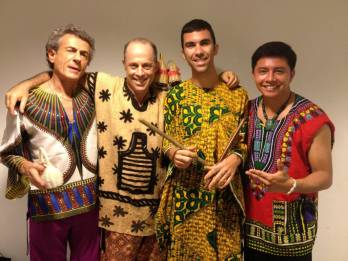
Back in the Bay Area, I met and studied with Bolokada Conde who had arrived from Guinea and been a star of the touring group, Les Percussions De Guinée. We hit it off and when he started his group Les Percussions Malinke, I was one of only two non-African soloists chosen to perform.
Over the last 16 years I have continued my travels, studying, performing, documenting, and sharing rhythms, music, and songs. I now share much of my information over the internet on YouTube as well as Facebook, where I administer several popular groups. My YouTube pages have many videos of classes, performances, and drumming from around the world and reach millions of viewers regularly. I play with various groups wherever I travel to and continue to learn and study.

Over the years I began taking trips to Asia for longer and longer periods. I first began going in the ’90s with my yoga teacher and health mentor Steve Wickes, who we called The Doctor. He knew where to go and where not to go and opened up a whole new world for me outside of the USA. Over time, I began to make friends and meet local musicians in Bali, Malaysia, India, and so on. In India I began to play in world music groups that combined music and drumming from many different drumming traditions. This helped me to open up further to the fact that drumming is “all music”. There is no one way or right or wrong way. There are many different paths leading to the same place: music.
I must conclude, after this ongoing privileged musical journey, that it’s not necessarily how well you play, but the spirit you invest in what you do. Your intention and connection to your soul and the joy and enthusiasm you bring to the Circle are essential.
